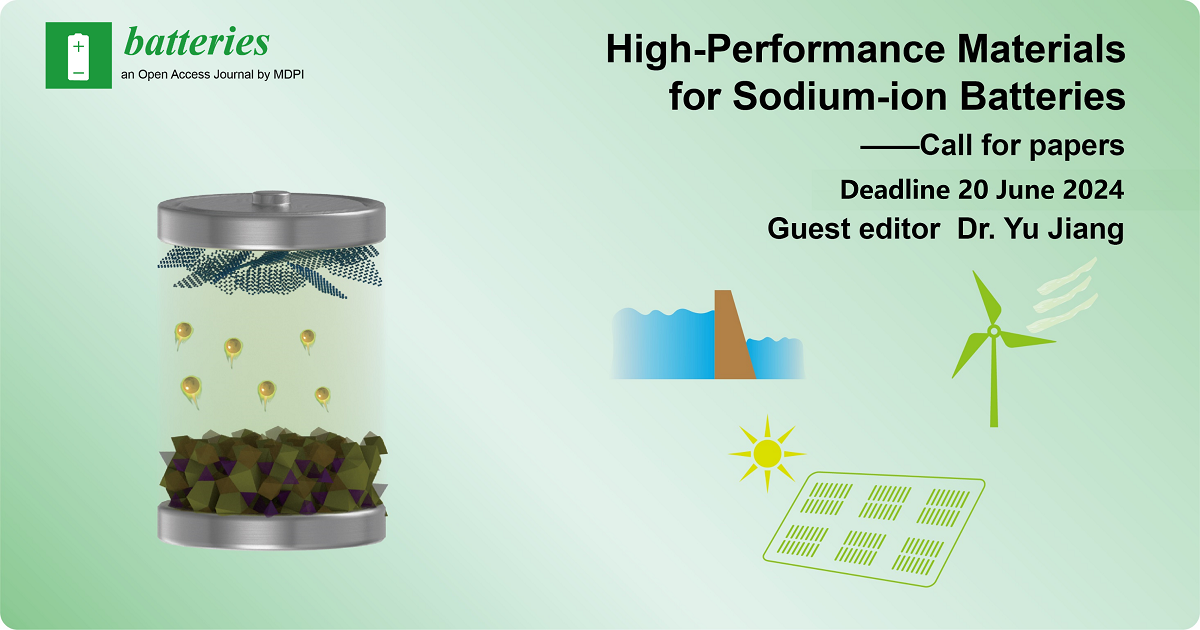High-Performance Materials for Sodium-Ion Batteries
A special issue of Batteries (ISSN 2313-0105). This special issue belongs to the section "Battery Materials and Interfaces: Anode, Cathode, Separators and Electrolytes or Others".
Deadline for manuscript submissions: 20 June 2024 | Viewed by 7238

Special Issue Editor
Special Issue Information
Dear Colleagues,
Sodium-ion batteries (NIBs) are an attractive alternative due to the abundance of their components in the earth and the low cost of sodium. Therefore, this Special Issue is designed to focus on updating the field of energy storage with the latest advances and prospects regarding various aspects of NIBs. Researchers are invited to submit their original research and review/perspective articles for publication in this Special Issue.
Topics of interest include, but are not limited to, the following:
- Various types of NIBs: metal oxides, polyanionic compounds, Prussian blue (PB), organic cathodes, Na-S, Na-O2;
- Design strategies of electrodes, electrolytes, and separators for NIBs;
- Solid electrolyte interphase (SEI);
- Cathode/electrolyte interphase (CEI);
- NIBs for low/high-temperature conditions;
- Battery life and safety;
- Flexible NIBs;
- Solid-state NIBs;
- NIBs for electric vehicles.
Dr. Yu Jiang
Guest Editor
Manuscript Submission Information
Manuscripts should be submitted online at www.mdpi.com by registering and logging in to this website. Once you are registered, click here to go to the submission form. Manuscripts can be submitted until the deadline. All submissions that pass pre-check are peer-reviewed. Accepted papers will be published continuously in the journal (as soon as accepted) and will be listed together on the special issue website. Research articles, review articles as well as short communications are invited. For planned papers, a title and short abstract (about 100 words) can be sent to the Editorial Office for announcement on this website.
Submitted manuscripts should not have been published previously, nor be under consideration for publication elsewhere (except conference proceedings papers). All manuscripts are thoroughly refereed through a single-blind peer-review process. A guide for authors and other relevant information for submission of manuscripts is available on the Instructions for Authors page. Batteries is an international peer-reviewed open access monthly journal published by MDPI.
Please visit the Instructions for Authors page before submitting a manuscript. The Article Processing Charge (APC) for publication in this open access journal is 2700 CHF (Swiss Francs). Submitted papers should be well formatted and use good English. Authors may use MDPI's English editing service prior to publication or during author revisions.
Keywords
- NIBs, Na-metal batteries, Na-S, Na-O2
- design strategies of electrodes, electrolytes, and separators
- solid electrolyte interphase (SEI)
- cathode/electrolyte interphase (CEI)
- low/high-temperature performance
- battery life and safety
- flexible NIBs
- solid-state NIBs
- electric vehicles
Planned Papers
The below list represents only planned manuscripts. Some of these manuscripts have not been received by the Editorial Office yet. Papers submitted to MDPI journals are subject to peer-review.
Title: Polymer Electrolytes for Sodium-Ion Batteries: A Review of Recent Developments
Authors: Kanakaraj Aruchamy1, Ramasundaram Subramaniyan1, Chang Woo Lee2,3, and Tae Hwan Oh1,*
Affiliation: 1 School of Chemical Engineering, Yeungnam University, Gyeongsan 38541, South Korea
2 Center for the SMART Energy Platform, College of Engineering, Kyung Hee University, 1732 Deogyeong-daero, Giheung, Yongin, Gyeonggi 17104, South Korea
3 Department of Chemical Engineering (Integrated Engineering Program), College of Engineering, Kyung Hee University, 1732 Deogyeong-daero, Giheung, Yongin, Gyeonggi 17104, South Korea
Abstract: Polymer electrolytes have gained attraction for their potential to improve the performance of sodium-ion batteries (SIBs) by enhancing safety and stability. This review article offers a comprehensive overview of recent developments in the field of polymer electrolytes for high-performance SIBs. The discussion covers various types of polymer electrolytes, including gel-polymer electrolytes (GPEs), solid-state electrolytes (SSEs) and composite polymer electrolytes (CPEs) focusing on their synthesis methods, physical properties, and electrochemical performance. The diverse approaches discussed in these studies contribute to the advancement of polymer electrolytes for high-performance sodium-ion batteries, demonstrating their potential for practical applications. It focuses on multiple research studies, each presenting distinct strategies to enhance electrolyte performance and its compatibility with sodium-ion systems. These strategies include incorporating nanoparticles, modifying crystal phases, using solvate ionic liquids, incorporating nanocellulose materials, adding fillers, and tailoring monomer designs. The findings provide insights into optimizing polymer electrolytes for safe, efficient, and stable sodium-ion energy storage systems. These studies collectively offer insights into strategies for enhancing sodium-ion battery performance through innovative electrolyte formulations, novel composite materials, and approaches to improve ionic conductivity and interfacial stability. The findings hold promise for advancing the field of sodium-ion batteries and contributing to the development of safer and higher-performance energy storage systems.





